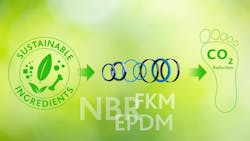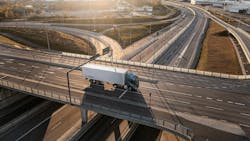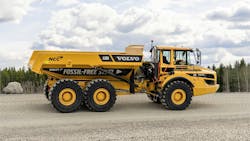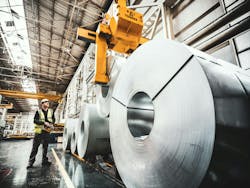Reduce Emissions Through New Materials and Production Methods
The materials from which components are made — such as steel, plastic and rubber — can play an important part in their performance and lifespan. Extracting, producing and utilizing these materials, however, can be energy intensive and dependent upon finite resources.
With an increased emphasis on sustainability across the entire supply chain, many companies are looking to new material options and production methods to mitigate environmental impacts, including those in and related to the fluid power and electric motion control sector.
Bio-Based Materials Provide More Sustainable Option
In an effort to reduce the use of finite raw materials such as petroleum which are used for plastics and rubber, many manufacturers and research organizations are looking into potential alternatives.
Chief among these are bio-based options made from plants and other renewable sources. SMC Corp., for instance, now offers biomass tubing produced from plant derived raw biomaterials such as castor seeds.
According to the company, reducing use of petroleum-based raw materials can lead to reductions in both carbon dioxide (CO2) and greenhouse gas (GHG) emissions, benefiting SMC and its customers’ decarbonization goals. This is possible because of the emissions associated with harvesting and refining raw materials which will no longer be created. In addition, bio-based materials have the potential to be recycled, further adding to emissions reduction opportunities.
READ MORE: Pneumatic Designs Evolving to Meet Industry Trends
Freudenberg Sealing Technologies is analyzing the possibility of using various sustainable substances for its seals. The company said these can include plant or animal sources as well as recycled materials.
“Our intention is to decrease the CO2 footprint of our products,” said Dr. Boris Traber, Director of Advanced Material Development for Freudenberg Sealing Technologies in Germany, in a press release discussing the company’s research in this area. “Some of our base polymers have a high CO2 footprint, and if we use sustainable fillers, we can achieve a smaller footprint. But at the same time, we do not want to compromise our sealing properties. The sustainable material must provide the same sealing functionality.”
Traber noted that customers are more interested today in utilizing sustainable materials which is helping drive Freudenberg’s development of them. Additionally, there are predictions that global oil reserves may only last another 50 years, emphasizing the need for alternatives to fossil-based materials.
Material experts at Freudenberg’s research & development laboratories in Plymouth, MI, are currently assessing numerous sustainable options including calcium phosphate derived from bone ash, an antioxidant extracted from Eucalyptus plants, sugarcane, grain chaff, and recycled rubber, among many others.
The company said extensive evaluation and testing is being undertaken to determine which sustainable materials can provide the same quality and performance as fossil-based options. Doing so is necessary to ensure Freudenberg continues to provide products that meet customer requirements.
Proceed with Caution When Using Alternative Materials
While there are many potential benefits to using bio-based and other material alternatives, it is important to properly assess all aspects of their use. As the study “The potential of emerging bio-based products to reduce environmental impacts” points out, on average emissions are 45% lower for emerging bio-based products. However, on an individual product basis the emissions savings can vary widely.
Researchers for this study believe it is necessary to evaluate environmental benefits on an individual product basis and that more development is required to reach global emissions-reduction targets.
There are many factors to consider with alternative materials. Some options may still be energy intensive to harvest and produce, negating their emissions reduction potential. It can also be costly to make the material, leading to costs being passed on to customers who may not see the value in using a more expensive option.
Freudenberg pointed out that one of the biggest challenges can be reliably sourcing plentiful, high-quality feedstocks that will result in consistent batch material production. The company went on to say that a poor growing season, the quality of a recycled source material, and other factors could all pose challenges.
Traber gave the example of sustainable carbon black. Processing sustainable carbon black from recycled tires is energy intensive and requires a consistent, high-quality source of tires. There is also market competition from tire manufacturers and other industries who want to use the material for their own sustainability efforts, presenting further challenges.
As Freudenberg noted, extensive testing is also required to ensure the chosen material will meet desired performance requirements. If they don’t, customers are less likely to purchase them which hinders market uptake and implementation of potential environmental benefits.
LEARN MORE: Sustainability, Education and Testing Important to Hallite’s Seal Development
Decarbonizing Steel Production
Steel is an important material for the manufacture of many fluid power and electric motion control components, as well as the machines in which they are used. Production of these materials, though, are a large contributor to carbon emissions.
Citing data from environmental advocacy group Industrious Labs, Politico reported in early 2024 that the steel industry is responsible for at least 7% of global GHG emissions and up to 30-50% of total emissions associated with the manufacture of cars.
This has prompted some producers and other organizations to investigate alternative methods for producing steel as well as other metals.
The Race to Green Steel initiative, for instance, was launched in February 2024, creating a coalition of environmental and transportation groups urging the production and use of so-called green steel — that which is made from sources other than coal such as hydrogen and renewable electricity.
Sweden- and U.S.-based steel producer SSAB initiated its efforts to produce fossil-free steel in 2016, culminating in its HYBRIT joint venture which produced what is thought to be the world’s first fossil-free steel in 2021. The HYBRIT technology replaces coal in the iron ore reduction process with hydrogen which the company states removes fossil carbon emissions, causing water instead of CO2 to be emitted during the steel production process.
Watch SSAB's video below to learn more about how the process works.
Since production of its first steel made with the HYBRIT technology, SSAB has been working with various OEMs and other customers to use this fossil-free steel product.
Mining equipment manufacturer Epiroc is one such example. The OEM is partnering with SSAB to research use of the fossil-free steel for spare parts and component production using additive manufacturing. They are starting with a hydraulic block utilized in the OEM’s mining rock drills which they believe will offer opportunities to improve its design.
Volvo Group is another OEM which has been working with SSAB to use its fossil-free steel since it first became available. Both the company’s truck and construction equipment divisions are utilizing the steel, demonstrating its ability to be used in heavy-duty applications. Volvo Construction Equipment (Volvo CE) unveiled its first concept machine made with the steel in October 2021, a load carrier for mining and quarrying, which it put through rigorous testing to validate the capabilities of fossil-free steel.
Nine months later, the company delivered its first production machine made with the SSAB steel to a customer, an A30G articulated hauler. The company stated in its press release announcing the delivery that use of SSAB’s steel is part of its goal to achieve net-zero GHG emissions by 2040. To do so, Volvo CE said it needs to reduce its carbon footprint across its entire value chain which includes the raw materials required to manufacture its machines and components. Continued use of the steel will be gradual, the company said and dependent upon various aspects such as availability of the fossil-free steel.
Stegra (formerly known as H2 Green Steel) is another company working to reduce the emissions associated with steel production. The Swedish startup uses green hydrogen — that which is produced from hydro- and wind-powered energy — to produce steel; the company states its process can achieve up to a 95% reduction in CO2 emissions, enabling it to offer a near-zero emissions product.
Volvo Group has signed a long-term agreement with Stegra to purchase its steel, further enhancing its decarbonization efforts. As a founding member of the First Movers Coalition, the company has committed to have at least 10% of all steel purchased per year be near-zero emissions by 2030 which the agreement with Stegra will help it achieve.
"The commercial vehicle industry has actively been driving the demand for green steel, validating the market interest. When [a] large player like Volvo Group, working at the forefront of sustainable change, places a customer order it’s a clear sign of confidence in both our company and our product,” said Henrik Henriksson, Stegra’s CEO, in the press release announcing the supply agreement with Volvo.
Schaeffler Group is also partnering with the startup, announcing in 2023 an increased investment in Stegra. The companies will work together to develop use of the near-zero emissions steel for electromobility solutions as well as rolling bearing products.
Like many manufacturers, Schaeffler has committed to reducing its carbon footprint with the current aim of becoming completely carbon neutral by 2040. By 2030 it wants to achieve climate neutrality in its own production processes (Scope 1 and 2) and a 25% reduction in its supply chain emissions (Scope 3 upstream) which will require decarbonizing the materials used for its products.
According to Schaeffler, the company uses an amount of steel equivalent to that in the Eiffel Tower each working day which is over 7,000 tons. Working with Stegra to use its steel will therefore play an important role in helping the company achieve its emissions-reduction goals.
Material selection is of course just one piece of the decarbonization puzzle, but an important one which these and other efforts being made by various component and machine manufacturers demonstrate.
About the Author
Sara Jensen
Executive Editor, Power & Motion
Sara Jensen is executive editor of Power & Motion, directing expanded coverage into the modern fluid power space, as well as mechatronic and smart technologies. She has over 15 years of publishing experience. Prior to Power & Motion she spent 11 years with a trade publication for engineers of heavy-duty equipment, the last 3 of which were as the editor and brand lead. Over the course of her time in the B2B industry, Sara has gained an extensive knowledge of various heavy-duty equipment industries — including construction, agriculture, mining and on-road trucks —along with the systems and market trends which impact them such as fluid power and electronic motion control technologies.
You can follow Sara and Power & Motion via the following social media handles:
X (formerly Twitter): @TechnlgyEditor and @PowerMotionTech
LinkedIn: @SaraJensen and @Power&Motion
Facebook: @PowerMotionTech

Leaders relevant to this article:






